Acer WLAN 11g Manual

Acer
WLAN 11g Broadband Router
User Manual

This product is in compliance with the essential requirements and other relevant provisions of the
R&TTE directive 1999/5/EC.
Product Name: |
Acer WLAN 11g Broadband Router |
|
|||
Model Name : |
WLAN-G-RU2 |
|
|
||
|
|
|
|
|
|
|
|
|
|
MAX. OUT POWER |
|
COUNTRY |
CHANNELS |
INDOOR |
OUTDOOR |
||
|
|
|
|
|
|
Spain |
|
2400-2483.5 MHz |
1-13 |
< 100 mW EIRP |
< 100 mW EIRP |
France |
|
2400-2454 MHz |
1-8 |
< 100 mW EIRP |
< 100 mW EIRP |
France |
|
2454-2483.5 MHz |
9-13 |
< 100 mW EIRP |
< 10 mW EIRP |
Italy |
|
2400-2483.5 MHz |
1-13 |
< 100 mW EIRP |
< 100 mW EIRP |
UK |
|
2400-2483.5 MHz |
1-13 |
< 100 mW EIRP |
< 100 mW EIRP |
Netherlands |
|
2400-2483.5 MHz |
1-13 |
< 100 mW EIRP |
< 100 mW EIRP |
Germany |
|
2400-2483.5 MHz |
1-13 |
< 100 mW EIRP |
< 100 mW EIRP |
Austria |
|
2400-2483.5 MHz |
1-13 |
< 100 mW EIRP |
< 100 mW EIRP |
Belgium |
|
2400-2483.5 MHz |
1-13 |
< 100 mW EIRP |
< 100 mW EIRP |
Switzerland |
|
2400-2483.5 MHz |
1-13 |
< 100 mW EIRP |
< 100 mW EIRP |
Luxemburg |
|
2400-2483.5 MHz |
1-13 |
< 100 mW EIRP |
< 100 mW EIRP |
Ireland |
|
2400-2483.5 MHz |
1-13 |
< 100 mW EIRP |
< 100 mW EIRP |
Portugal |
|
2400-2483.5 MHz |
1-13 |
< 100 mW EIRP |
< 100 mW EIRP |
Norway |
|
2400-2483.5 MHz |
1-13 |
< 100 mW EIRP |
< 100 mW EIRP |
Denmark |
|
2400-2483.5 MHz |
1-13 |
< 100 mW EIRP |
< 100 mW EIRP |
Finland |
|
2400-2483.5 MHz |
1-13 |
< 100 mW EIRP |
< 100 mW EIRP |
Iceland |
|
2400-2483.5 MHz |
1-13 |
< 100 mW EIRP |
< 100 mW EIRP |
Greece |
|
2400-2483.5 MHz |
1-13 |
< 100 mW EIRP |
< 100 mW EIRP |
Lichtenstein |
|
2400-2483.5 MHz |
1-13 |
< 100 mW EIRP |
< 100 mW EIRP |
Sweden |
|
2400-2483.5 MHz |
1-13 |
< 100 mW EIRP |
< 100 mW EIRP |
Copyright
Copyright 2004 by Acer Inc., All rights reserved. No part of this publication may be reproduced, transmitted, transcribed, stored in a retrieval system, or translated into any language or computer language, in any form or by any means, electronic, mechanical, magnetic, optical, chemical, manual or otherwise, without the prior written permission of Acer Computer GmbH
Disclaimer
Acer Inc. makes no representations or warranties, either expressed or implied, with respect to the contents hereof and specifically disclaims any warranties, merchantability or fitness for any particular purpose. Any software described in this manual is sold or licensed "as is". Should the programs prove defective following their purchase, the buyer (and not this company, its distributor, or its dealer) assumes the entire cost of all necessary servicing, repair, and any incidental or consequential damages resulting from any defect in the software. Further, Acer Computer GmbH, reserves the right to revise this publication and to make changes from time to time in the contents hereof without obligation to notify any person of such revision or change.
All brand and product names mentioned in this manual are trademarks and/or registered trademarks of their respective holders.

|
Contents |
|
1. OVERVIEW ................................................................................................................. |
3 |
|
1.1 |
Product Feature................................................................................................... |
3 |
1.2 |
System Requirements ......................................................................................... |
3 |
1.3 Applications........................................................................................................ |
3 |
|
2. Installing Your Router .................................................................................................. |
1 |
|
2.1 |
Installation Instructions ...................................................................................... |
1 |
3. Preparing Your Network............................................................................................... |
2 |
|
3.1 |
Configuring Windows for IP Networking .......................................................... |
2 |
3.2 To Configure Windows to Receive Dynamic IP Address:.................................. |
2 |
|
3.3 |
Collecting ISP Information................................................................................. |
4 |
4. Basic Functions ............................................................................................................ |
5 |
|
4.1 |
To Open the Web-based Administration Tool:.................................................... |
5 |
4.2 |
Setup ................................................................................................................... |
7 |
4.3 |
Global Address .................................................................................................. |
11 |
4.4. Wireless ........................................................................................................... |
14 |
|
4.5 |
Tools ................................................................................................................. |
23 |
4.6 |
Status ................................................................................................................ |
27 |
4.7 DHCP ............................................................................................................... |
30 |
|
4.8 |
Log.................................................................................................................... |
32 |
4.9 |
Statistics............................................................................................................ |
35 |
5. Advanced Function..................................................................................................... |
36 |
|
5.1. To Toggle between Basic Functions and Advanced Functions: ...................... |
36 |
|
5.2 |
Virtual Servers .................................................................................................. |
37 |
5.3 |
Filters................................................................................................................ |
40 |
5.4 |
IP/URL Block ................................................................................................... |
44 |
5.5 |
Special Apps ..................................................................................................... |
47 |
5.6 DMZ Host......................................................................................................... |
51 |
|
5.7 MAC Clone ...................................................................................................... |
53 |
|
5.8 Dynamic DNS .................................................................................................. |
54 |
|
5.9 Proxy DNS........................................................................................................ |
56 |
|
5.10 SNMP ............................................................................................................. |
58 |
|
5.11 Static Routing ................................................................................................. |
61 |
|
2

1. OVERVIEW
1.1 Product Feature
▪Compliance with IEEE 802.11g and 802.11b standards
▪Highly efficient design mechanism to provide unbeatable performance
▪Strong network security with WEP and 802.1X encryption
▪Achieving data rate up to 54Mbps for 802.11g and 11Mbps for 802.11b with wide range coverage; high performance to deliver up to 54Mbps raw data rate for 802.11g
▪Quick and easy setup with Web-based management utility
1.2 System Requirements
▪Windows 98, 98SE, Millennium Edition (ME), 2000 and XP operating systems
▪Microsoft Internet Explorer 5.5 or higher
▪DSL/ Cable Modem Broadband Internet connection and ISP account
▪PCs equipped with 10 Mbps or 10/100 Mbps Ethernet connection to support TCP/IP protocol
▪One CD-ROM driver
1.3 Applications
▪Home SOHO networking for device sharing and wireless multimedia
▪Wireless office provides a wider range for home and SOHO Ethernet
▪Enables wireless building-to-building data communication
▪Built-in infrastructure mode
▪Router provides ideal solution for:
Temporary LANs for scenarios such as trade-exhibitions and meetings
Enables LAN adaptability to frequently changing environments
Enables remote access to corporate network information, for example e-mail and company home page
3
2. Installing Your Router
In this chapter, you’ll learn how to connect your router.
2.1 Installation Instructions
To Connect the Router:
2.1.1.Make sure all equipments are turned off, including the router, Desktop or Laptop PCs, the cable and DSL modem, and so on.
2.1.2.Connect the WAN Port of the router to the cable and DSL modem, Ethernet Server or the hub.
2.1.3.Connect your client PCs to the LAN Ports.
2.1.4.Connect the Power Adaptor (5VDC, 1.2A) to the power jack of the router and plug the power cable into the outlet.
2.1.5.Turn on our PCs.
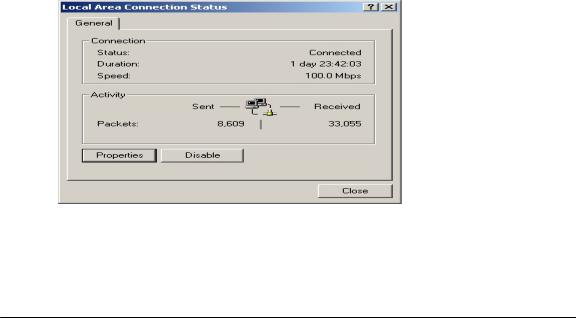
3. Preparing Your Network
In this chapter, you’ll learn what to do before configuring your network.
Before configuring your router, you need set up the computers in your network for TCP/IP networking and collect relevant ISP information if necessary.
3.1 Configuring Windows for IP Networking
Each computer in your network should be configured for TCP/IP networking. There are two ways to configure your computers:
▪You are commended to use DHCP, then you can simply choose to receive an IP address automatically. For detailed instructions, see Configure Windows to Receive Dynamic IP Address.
▪If you don’t use DHCP, you need assign an IP address to each computer manually. For detailed instructions, refer to your Windows Documentation.
3.2 To Configure Windows to Receive Dynamic IP Address:
3.2.1.Click Start, then choose Settings > Network and Dial-up Connections.
3.2.2.Select the name of your ISP connection.
The Local Area Connection Status dialog box appears, seen in FIGURE 3-1:
FIGURE 3-1: Local Area Connection Status dialog box
3.2.3. Click Properties.
2
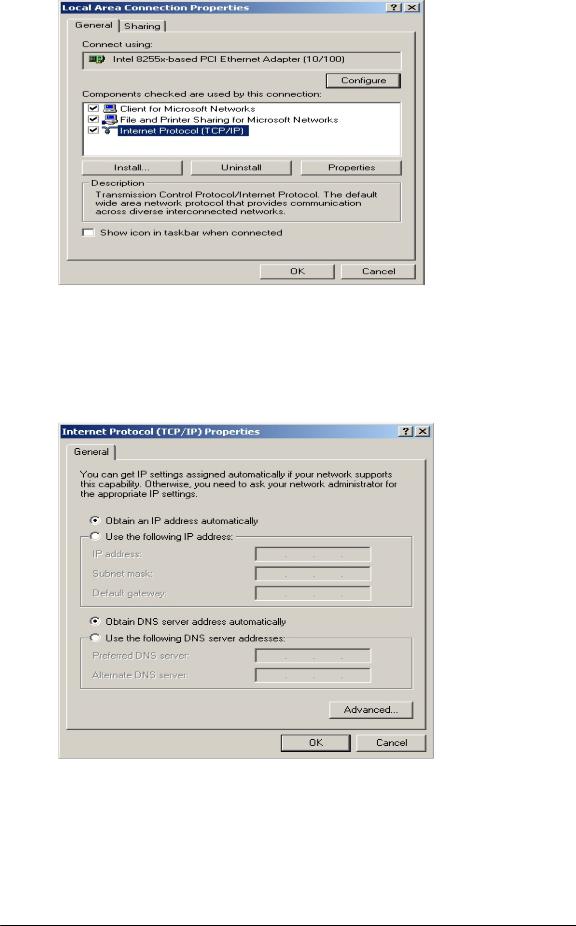
The Local Area Connection Properties dialog box appears, seen in FIGURE 3-2:
FIGURE 3-2: Local Area Connection Properties dialog box.
3.2.4. Click Internet Protocol (TCP/IP), then click Properties.
The Internet protocol (TCP/IP) Properties dialog box appears, seen in FIGURE 3-3:
FIGURE 3-3: Internet Protocol (TCP/IP) Properties dialog box
3.2.5.Click Obtain an IP address automatically and Obtain DNS server address automatically.
3.2.6.Click OK.
3

You need restart your computer now or at a later time.
Note :
The procedural steps above apply to Windows 2000 only. For Windows 95/98/ME/NT/XP, refer to your Windows Documentation.
3.3 Collecting ISP Information
You need query the relevant information from your ISP before configuring your router, for example:
▪Has your ISP assigned you a static or dynamic IP address? If you have obtained one static IP address, what is it?
▪Does your ISP use PPPoE? If so, what is your PPPoE user name and password?
If you are not sure of the above questions, call your ISP to clarify them.
4
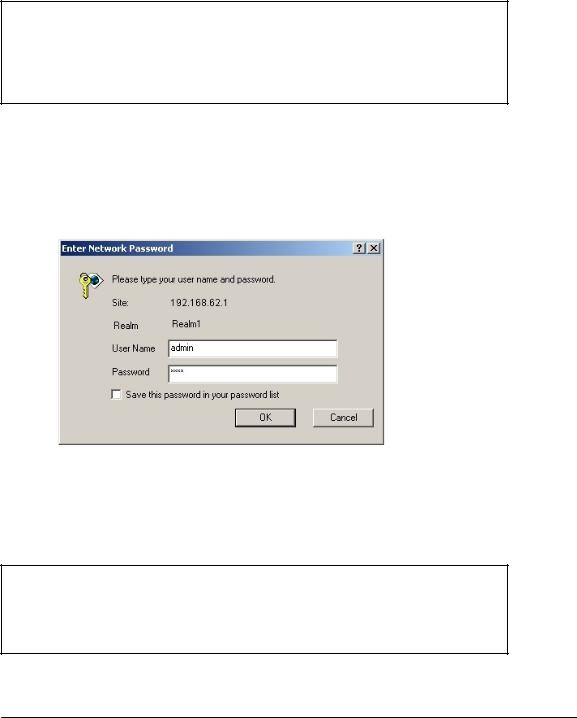
4. Basic Functions
In this chapter, you will learn how to use basic functions that the Company AP Router provides, including Setup, Global Address, Wireless Tools, Status, DHCP, Log and Printer.
The Acer WLAN 11g Broadband Router provides you a Web-based Administration Tool with which you can easily set up the router and customize the basic router settings. You can use this Web-based Tool from any computer in your network.
Notes :
Microsoft Internet Explorer 5.0 or later is highly recommended for using this Web-based Tool.
Graphics sampled in this chapter are provided for illustrations only. They may slightly differ from your own router screens.
4.1To Open the Web-based Administration Tool:
4.1.1.Open the browser on your PC.
4.1.2.Type http://192.168.62.1 in the Address bar.
The Logon dialog box appears, seen in FIGURE 4-1:
FIGURE 4-1: Logon dialog box
4.1.3.Type admin in the User Name box.
4.1.4.Type the password in the box.
Note :
The default password is “1234”. You can change the password on the Tools page. For detailed instructions, see To Change the Administrative Password for Your Router.
5

4.1.5.Optional. To log on to the Administration Tool once for all, select the check box of Save this password in your password list.
4.1.6.Click OK.
Note :
The Administration Tool will time out after a period of idling, the Router may ask you to log on again.
The Company AP Router Administration Tool appears.
6
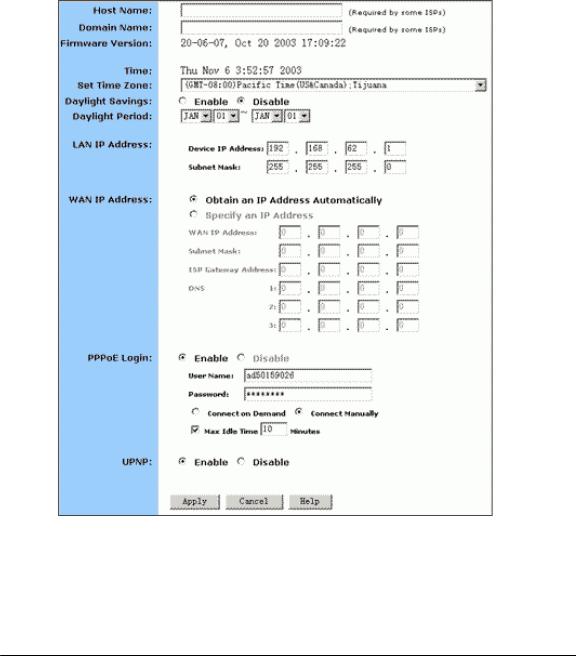
4.2 Setup
The Setup page allows you to edit the basic configuration parameters for your router, such as Host Name, Domain Name, LAN IP Address, WAN IP Address, PPPoE Login, UPNP, and so on.
In most cases, the default settings will be Okay for you. However, different ISPs (Internet Service Provider) may ask for specific requirements, please check it with your ISP if you are not sure.
4.2.1.To Configure Setup Parameters:
4.2.1.1.Click Setup on the navigation bar.
The Setup page appears, seen in FIGURE 4-2:
FIGURE 4-2: Setup page
4.2.1.2.Type the Host Name, System Name or Account Name in the Host Name box if your ISP requires.
7
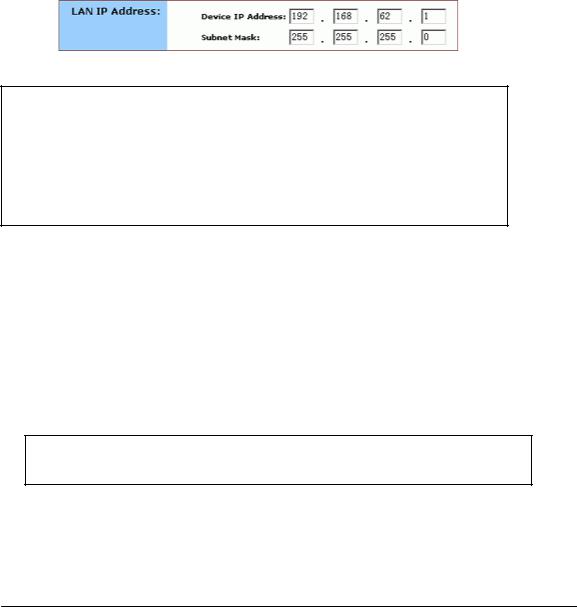
4.2.1.3.Type the Domain Name of your ISP in the box if your ISP requires, such as xyz.isp.com.
4.2.1.4.Optional. Review the firmware version number and date information that you are currently using.
4.2.1.5.Select a specific Time Zone from the Set Time Zone drop-down list, such as (GMT+08:00) Beijing, Chongqing, Hong Kong, Urumqi.
4.2.1.6.If you want to use Daylight Savings time, click Enable and select the start date and end date from the Daylight Period drop-down lists.
4.2.1.7.If you don’t want to use Daylight Savings time, click Disable. If you select to disable the Daylight Savings, Daylight Period will not take effect any more.
4.2.1.8.Optional. Review the Device IP Address and Subnet Mask next to LAN IP Address and change the information if necessary.
Notes :
Device IP Address and Subnet Mask are invisible to users on the LAN (Local Area Network) only.
In most cases, you need not make any change to LAN IP Address. If you change the LAN IP Address with DHCP enabled, you need to restart your client PCs; otherwise, you need reconfigure your client’s IP addresses manually.
4.2.1.9.If you have enabled the DMZ feature on the DHCP page, review the DMZ IP Address and Subnet Address next to DMZ IP Address and change the information if necessary.
4.2.1.10.For WAN IP Address (Wide Area Network, also called Public IP), choose either Obtain an IP Address automatically or Specify an IP Address if your ISP has assigned you with static IP).
Note :
If you choose to obtain an IP Address automatically, skip Step
4.2.1.11.Optional. If you select Specify an IP Address, type the WAN IP Address, Subnet Mask, ISP Gateway Address and DNS in
8
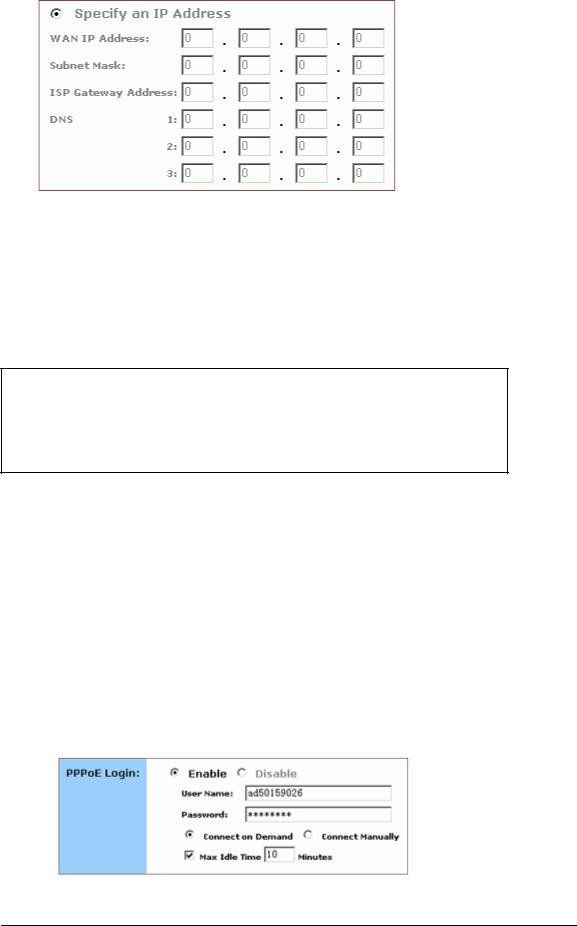
the boxes, seen in FIGURE 4-3. You can collect such information from your ISP.
FIGURE 4-3: WAN IP Address - Specify an IP Address
4.2.1.12.If your ISP uses PPPoE (Point to Point Protocol over Ethernet), click Enable next to PPPoE Login; otherwise, click Disable. For detailed instructions on how to set the PPPoE Login parameters in FIGURE 3-4, see To Set PPPoE Login Parameters below.
Notes :
Using PPPoE, your ISP can authenticate your connection with a specific user name and password for security issues.
If you enable PPPoE, make sure to uninstall all existing applications on any computer in your network.
4.2.113. If you want to use UPNP (Universal Plug and Play) to plug devices like PCs, routers and others into a network and to automatically know about each other, click Enable next to UPNP; otherwise, click Disable.
4.2.1.14.When you have completed all the settings, click Apply, or click Cancel to undo your changes.
4.2.2.To Set PPPoE Login Parameters:
4.2.2.1.Click Enable next to PPPoE Login.
FIGURE 4-4: Set PPPoE Login Parameters
9

4.2.2.2.Type the User Name and Password provided by your ISP.
4.2.2.3.For connection types, you can select either Connect on Demand or Connect Manually.
4.2.2.4.Optional. If you want to limit the idling minutes, select Max Idle Time and type a maximum number in minutes.
10
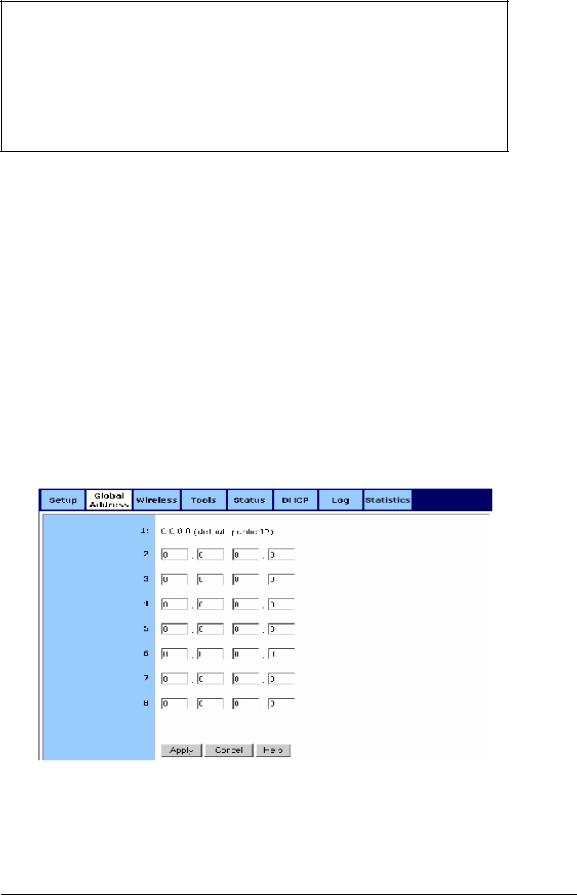
4.3 Global Address
On the Global Address page, you can set up NAT (Network Address Translation) to provide internal-to-external IP address mappings.
Notes :
If you want to use Global Address mapping, you must enable NAT on the Filters page. For detailed instructions, see To Set up a Port Filtering or Raw IP Filter.
If you have chosen to retrieve an IP address automatically, you will not need to use this function. Instead, the default public IP address will display on the Global Address page.
Have you enabled DMZ on the DHCP page? Depending on whether DMZ is enabled, you may follow different procedural steps.
What do you want to do?
▪Set up Global Address with DMZ Disabled
▪Set up Global Address with DMZ Enabled
▪Remove Global Addresses
4.3.1.To Set up Global Address with DMZ Disabled:
4.3.1.1.Click Global Address on the navigation bar.
The Global Address page with DMZ Disabled appears, seen in FIGURE 4-5:
FIGURE 4-5: Global Address Page with DMZ Disabled
4.3.1.2.Review the first line in the above figure. It shows the default WAN IP address which is specified on the Setup page. If your
11
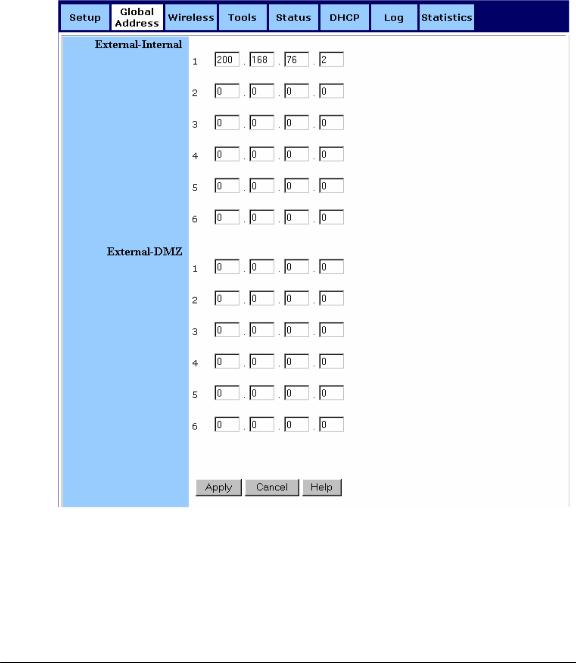
ISP assigns you an IP address automatically, it will display here.
4.3.1.3.In Line 2 – Line 8, you can list up to 7 additional static, external IP addresses provided by your ISP.
4.3.1.4.When you have completed editing all the settings, click Apply, or click Cancel to undo your changes.
4.3.2.To Set up Global Address with DMZ Enabled:
4.3.2.1.Click Global Address on the navigation bar.
The Global Address page with DMZ Enabled appears, seen in FIGURE 4-6:
FIGURE 4-6: Global Address Page with DMZ Enabled
4.3.2.2.Review the first line in the above figure. It shows the default WAN IP address which is specified on the Setup page. If your ISP assigns you an IP address automatically, it will display here.
12

4.3.2.3.Next to External - Internal, you can list up to 6 static, external IP addresses provided by your ISP.
4.3.2.4.Next to External – DMZ, define for your DMZ network up to 6 static, external global IP addresses provided by your ISP.
4.3.2.5.When you have completed editing all the settings, click Apply, or click Cancel to undo your changes.
4.3.3.To Remove Global Addresses:
4.3.3.1.Click Global Address on the navigation bar.
4.3.3.2.For any entry you want to delete, enter 0.0.0.0, and click Apply.
13

4.4. Wireless
Using Wireless, you can configure your router for wireless access. There are three parts on the Wireless page:
▪Radio Settings: Allows you to configure your Gateway for wireless access, including Wireless Enable/Disable, Mode, ESSID, Beacon Interval, RTS Threshold, Preamble Type, Distribution System, and so on.
▪Security Setting: Allows you to configure your Gateway for security issues.
▪Status: Allows you to find out your Gateway’s AP Radio statistics and wireless devices of which the AP (Access Point) is aware.
You can easily toggle between the above three parts on the Wireless page.
On the Radio Settings page, Wireless Distribution System as defined by the IEEE 802.11 standard has been made available on the Company AP Router now. Hence, it is possible to wirelessly connect Access Points using up to 8 MAC Addresses of PC cards, so that you can extend a wired infrastructure to locations where cabling is not available. Thus those users can roam or stay connected to the available network resources.
What do you want to do?
▪Set the Wireless Radio Parameters
▪Set the Wireless Security Parameters
▪Review Wireless Status
▪Disable Wireless
4.4.1.To Set the Wireless Radio Parameters:
4.4.1.1.On the Wireless page, select Radio Settings.
The Radio Settings page appears, seen in FIGURE 4-7:
14
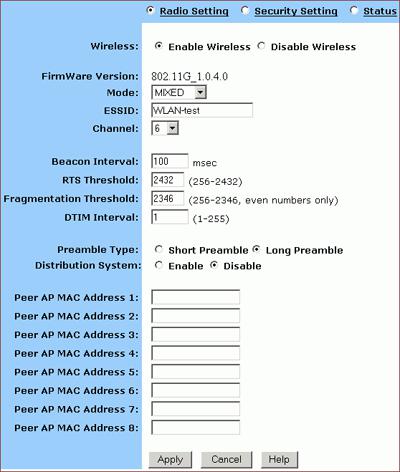
FIGURE 4-7: Wireless – Radio Settings Page
4.4.1.2.Click Enable next to Wireless.
4.4.1.3.Optional. Review the firmware version number and date information that you are currently using.
4.4.1.4.Enter the following basic radio parameters:
|
Parameter |
Description |
|
|
|
|
|
|
Mode |
Selects the Wireless Mode that your Company AP |
|
|
|
Router supports from the drop-down list. |
|
|
|
Available options are 802.11B, 802.11G, and |
|
|
|
MIXED which supports both 802.11B and 802.11G. |
|
|
|
|
|
|
ESSID |
Type the unique identifier for the Extended Service |
|
|
|
Set which is shared by client stations in an |
|
|
|
infrastructure association, such as WLAN-test. |
|
|
|
It is case-sensitive and cannot exceed 32 characters. |
|
|
|
|
|
|
Channel |
Selects one IEEE 802.11G channel for wireless |
|
|
|
LAN transmissions from the drop-down list. |
|
|
|
Specifies the bandwidth which the wireless radio |
|
|
|
operates. AP and the client stations that is |
|
|
|
15 |
|

associated work in one of channels from 1 to 14.
4.4.1.5. Enter the following advanced radio parameters:
|
Parameter |
Description |
|
|
|
|
Beacon |
Type the time interval in milliseconds |
|
Interval |
between beacons broadcast by AP (Access |
|
|
Point) in the Beacon Interval box, such as 100. |
|
|
|
|
RTS Threshold |
Type a number in the RTS Threshold box. |
|
|
Also called Request-to-Send Threshold. This |
|
|
field specifies the minimum size of data |
|
|
frames above which RTS protocol is used, |
|
|
ranging from 256 to 2432. RTS helps prevent |
|
|
data collision from hidden nodes. |
|
|
|
|
Fragmentation |
Type a number in the Fragmentation |
|
Threshold |
Threshold box. |
|
|
For efficiency in high-traffic situations, large |
|
|
files are split into fragments. This field |
|
|
specifies the default packet size, an even |
|
|
number ranging from 256 to 2346. |
|
|
|
|
DTIM Interval |
Type a number in the DTIM Interval box. |
|
|
Also called Delivery Traffic Indication Map. |
|
|
This field specifies the number of beacon |
|
|
intervals between successive DTIMs, ranging |
|
|
from 1 to 255. |
|
|
|
|
Preamble Type |
Select either Short Preamble (72 bits) or Long |
|
|
Preamble (144 bits). |
|
|
|
|
Distribution |
If you want to use Wireless Distribution |
|
System |
System on your Router, click Enable next to |
|
|
Distribution System, then type the distributed |
|
|
client PCs’ physical addresses, as described |
|
|
in Step 6. |
|
|
Otherwise, click Disable. |
|
|
|
Note :
You can see the default values of the above advanced wireless settings on the right of the page. If you don’t know how to change the settings, please leave as they are in Figure 4-8:
16
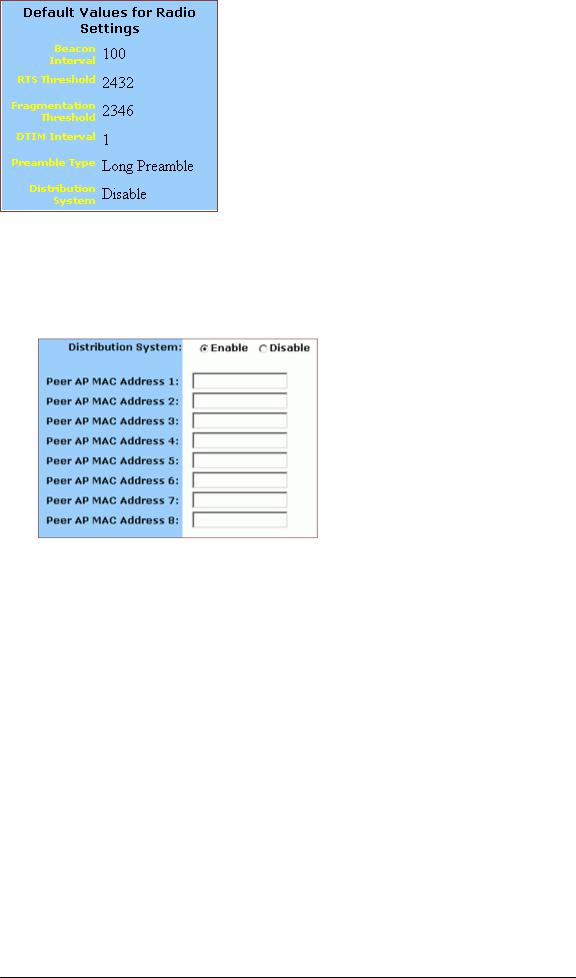
FIGURE 4-8: Default Values for Radio Settings
4.4.1.6.Optional. If you have enabled Distribution System, type the physical addresses of distributed client PCs in a wireless network in the Peer AP MAC Address 1-8 boxes, seen in FIGURE 4-9:
FIGURE 4-9: Peer AP MAC Addresses for Distribution Systems
4.4.1.7.When you have completed editing all the settings, click Apply, or click Cancel to undo your changes.
4.4.2.To Set Wireless Security Parameters:
4.4.2.1.Click Security Settings on the Wireless page.
The Security Settings appears, seen in FIGURE 4-10:
17
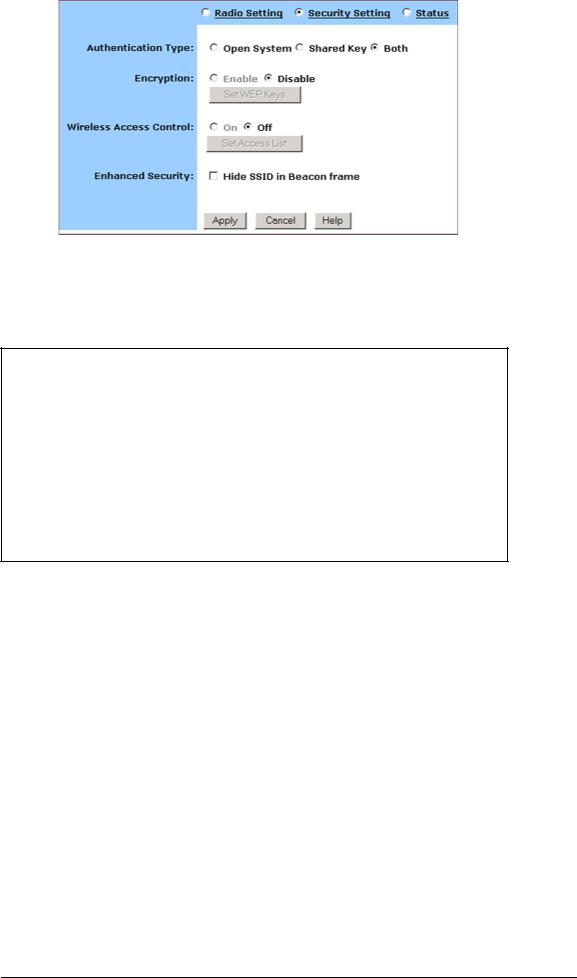
FIGURE 4-10: Wireless – Security Settings Page
4.4.2.2.Select one of Open System, Shared Key and Both from the Authentication Type drop-down list.
Notes :
Authentication Type indicates an authentication algorithm which can be supported by the Access Point:
Open System: The simplest of available authentication algorithms. Essentially it is a null algorithm. Any station that requests authentication with this algorithm may become authenticated if Open System is set at the recipient station.
Shared Key: Allows stations with a specific WEP (Wired Equivalent Privacy) Keys to be authenticated.
Both: Supports the authentications of either stations who know a shared key or those who do not.
If you want to prevent other stations without specific WEP (Wired Equivalent Privacy) keys from linking to the AP, select Enable next to Encryption and then click Set WEP Keys to specify relevant keys; otherwise, select Disable. For detailed instructions on how to set the WEP Keys, see below To Set WEP Keys.
If you want to allow access to the Internet based on user’s MAC (Media Access Control) address, select On next to Wireless Access Control and then click Set Access List to specify relevant MAC addresses; otherwise, click Off. For detailed instructions on how to specify relevant MAC addresses, see below To Set Wireless Access Control.
4.4.2.3.Next to Enhanced Security, select either Enable or Disable. If you choose to enable the enhanced security feature, go to Step 6.
18
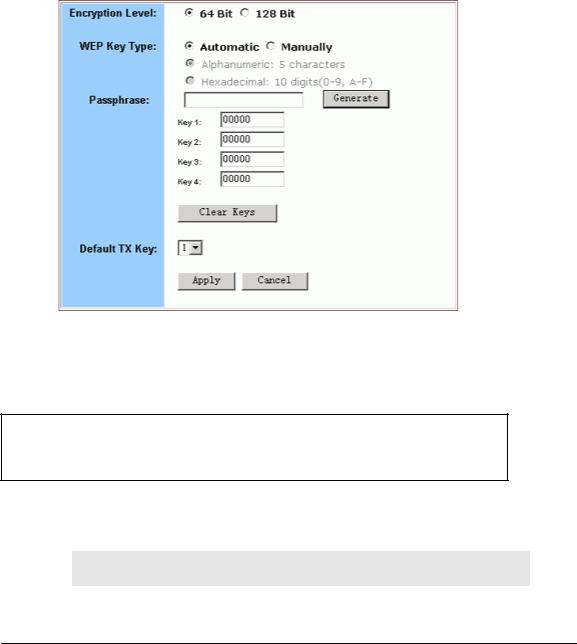
4.4.2.4.Optional. If you have enabled Enhanced Security, you can choose to hide your SSID (Service Set Identifier) in Beacon frame.
4.4.2.5.When you have completed editing all the settings, click Apply, or click Cancel to undo your changes.
4.4.3.To Set WEP Keys:
4.4.3.1.On the Security Settings page, enable the Encryption and click Set WEP Keys.
The Set WEP Keys window appears, seen in FIGURE 4-11:
FIGURE 4-11: Set WEP Keys Window
4.4.3.2. Select either 64 Bit or 128 Bit next to Encryption Level.
Note :
128 Bit encryption can provide you a more secure encryption algorithm, but it will slow down your network data transmission rates.
4.4.3.3.If you want to generate WEP Keys automatically, do the following action:
4.4.3.3.1.Select Automatic next to WEP Key Type.
19

4.4.3.3.2.Type a string of any words in the Passphrase box, and click Generate.
Four newly generated WEP Keys will display in the Key 1 – Key 4.
4.4.3.3..3. Optional. Click Clear Keys to reset all the keys to null.
Note :
Make sure that you write down the passphrase string, so that you can refer to it if necessary.
4.4.3.4.If you want to enter the key elements manually, do the following action:
4.4.3.4.1.Select Manually next to WEP Key Type.
4.4.3.4.2.If you select Alphanumeric: 5 characters, type a string of 5 alphanumeric characters in the Key 1 – Key 4 boxes respectively.
4.4.3.4.3.If you select Hexadecimal: 10 digits (0-9, A-F), type a string of 10 hexadecimal digits in the Key 1 – Key 4 boxes respectively.
4.4.3.4.4.Optional. Click Clear Keys to reset all the keys to null.
4.4.3.5.Select the default encryption key from the Default TX Key
drop-down list, such as Key 1.
4.4.3.6.When you have completed editing all the settings, click Apply, or click Cancel to undo your changes.
4.4.4.To Set Wireless Access Control:
4.4.4.1.On the Security Settings page, set the Wireless Access Control On and click Set Access List.
The Window Control List window appears, seen in FIGURE
4-12:
20
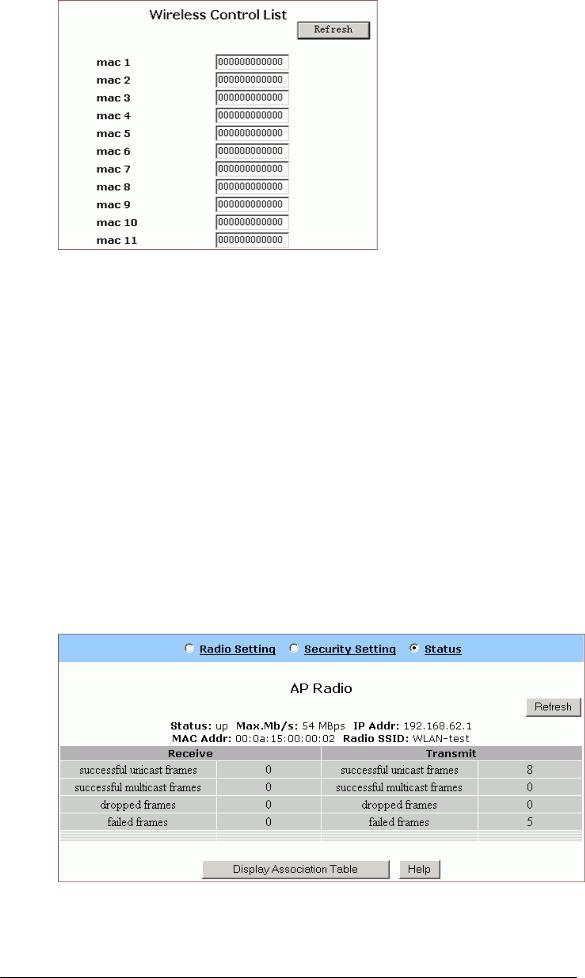
FIGURE 4-12: Wireless Control List window
4.4.4.2.Type the MAC addresses that you want to allow to access the Internet. You can specify up to 80 MAC addresses in the list.
4.4.4.3.When you have complete editing all the MAC addresses, click Submit, or click Cancel to undo your changes.
4.4.4.4.Optional. You can click Refresh to see the most current MAC addresses in effect.
4.4.5.To Review Wireless Status:
4.4.5.1.On the Wireless page, select Status.
The Status page appears with your GateWay’s AP Radio statistics including Status, Max.Mb/s, IP Addr, MAC Addr, Radio SSID, Receive data and Transmit data. Seen in FIGURE 4-13:
FIGURE 4-13: Wireless – Status Page
21
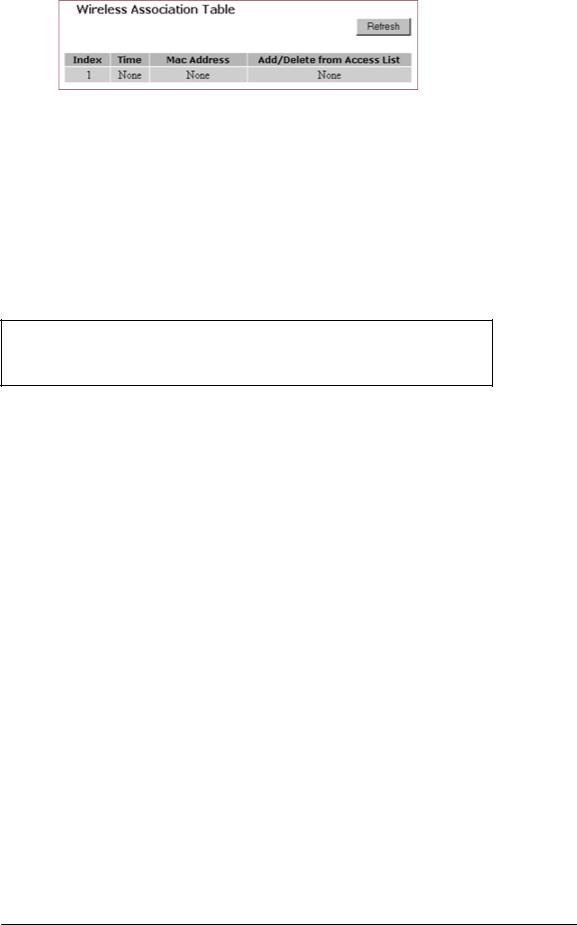
4.4.5.2.To see the wireless devices of which the AP (Access Point) is aware, click Display Association Table.
4.4.5.3.Optional. You can click Refresh to see the most current data.
4.4.6.To Disable Wireless:
4.4.6.1.On the Wireless page, select Radio Settings.
The Radio Settings page appears, seen in FIGURE 4-7.
If you don’t want the router to support Wireless, select Disable.
Note :
None of the router’s wireless functions will work unless you enable it.
22
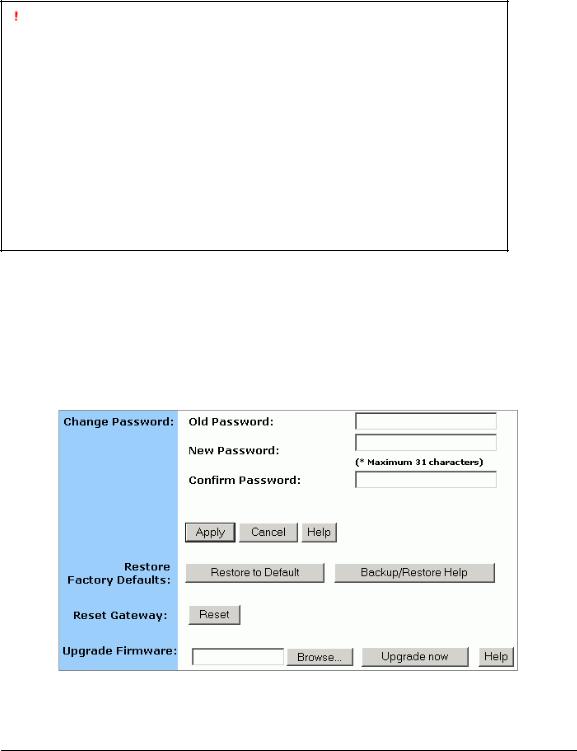
4.5 Tools
On the Tools page, you can:
▪Change the Administrative Password for Your Router
▪Restore the Factory Default Configuration
▪Reset Gateway
▪Upgrade the Firmware
Important:
We strongly recommend that you change the administrative password after the first login.
Restoring the default factory settings will reset all of the router configurations in every page, so we recommend that you backup the configuration data from the Gateway to your PC simply using DOS commands. In addition, you can also restore the factory defaults under the DOS window. For detailed instructions, see To Backup or Restore the Configuration Data Using DOS Commands.
If you want to reset the hardware, you need reset the Gateway. Before upgrading the firmware, you need download the firmware image file from the Gateway Web site and save it to your root local drive first.
4.5.1. To Change the Administrative Password for Your Router:
4.5.1.1. Click Tools on the navigation bar.
The Tools page appears, seen in FIGURE 4-14:
FIGURE 4-14: Tools Page
23

4.5.1.2.Type the Old Password in the box. The default password is
1234.
4.5.1.3.Type a New Password in the box.
Note :
Password must be less than 64 characters.
4.5.1.4.Type the new password in the Confirm Password box.
4.5.2.To Restore the Factory Default Configuration:
4.5.2.1.On the Tools page, click Restore to Default next to Restore Factory Defaults.
The Warning dialog box appears, see FIGURE 4-15:
FIGURE 4-15: Warning Dialog Box
4.5.2.2. Click OK.
Important:
Restoring the default factory settings will reset all of the router configurations in every page, so we recommend that you backup the configuration data from the Gateway to your PC first using DOS commands. For details, see To Backup or Restore the Configuration Data Using DOS Commands.
In addition, you can also restore the factory defaults using DOS commands. For detailed instructions, see To Backup or Restore the Configuration Data Using DOS Commands.
4.5.3.To Backup or Restore the Configuration Data Using DOS Commands:
For the backup of the configuration data from the Gateway to your PC, Gateway acts as a TFTP server.
To backup the configuration data, under the DOS window, use the following command:
tftp –i gateway_Ip_address GET filename
24
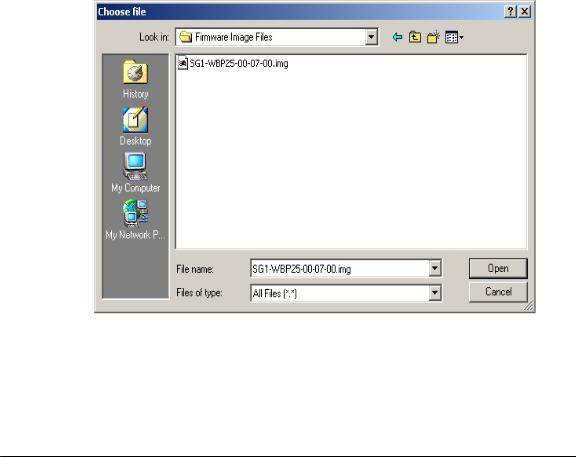
To restore the configuration data, under the DOS window, use the following command:
tftp –i gateway_Ip_address PUT filename
gateway_Ip_address: The IP address of the Gateway where you want to back the configuration data.
filename: The file name for backup from the Gateway. It must begin with “nvram” which is not case-sensitive, such as “nvram__11032003”.
4.5.4. To Reset Gateway:
If you want to reset the hardware, click Reset next to Reset Gateway on the Tools page.
4.5.5.To Upgrade the Firmware:
4.5.5.1.Download a firmware image file from the Gateway Web site and save it to your root local drive.
4.5.5.2.Type the file path and file name in the Upgrade Firmware box, or click Browse to launch a Choose file dialog box, seen in FIGURE 4-15:
FIGURE 4-15: Choose File Dialog Box for Upgrading
Firmware
4.5.5.3. Locate the firmware you have downloaded and click Open.
25
